Traveling the world is an incredible experience, but staying connected can be a challenge. How much data do you need when traveling? TRAVELS.EDU.VN is here to help you estimate your data needs and find the best solutions for staying online, from understanding app usage to exploring eSIM options. Enjoy seamless connectivity with TRAVELS.EDU.VN and share every breathtaking moment worry-free. Explore connectivity solutions, international data roaming, and mobile data packages.
1. Understanding Your Travel Data Needs
When you’re exploring a new destination, staying connected is more important than ever. However, it’s easy to underestimate how much data you’ll actually need. Here’s a breakdown of factors that can significantly impact your data usage during your trip:
- Limited or Unreliable WiFi: Public WiFi can be spotty or nonexistent outside of tourist hotspots. You’ll likely need mobile data for maps, communication, and accessing important information.
- Navigation Apps: Real-time tracking and route updates from apps like Google Maps can quickly drain your data allowance.
- Background Data: Cloud syncing, messaging app notifications, and automatic updates can silently consume data in the background.
- Social Media and Streaming: Sharing your adventures on social media, making video calls, and streaming entertainment can add up quickly.
To accurately estimate your data needs, consider your typical usage patterns. Are you a light user who mainly checks emails and browses the web? Or are you a heavy user who relies on video calls, streaming, and constant social media updates?
1.1. Estimating Data Usage Based on User Type
To get a better idea of how much data you might need, consider these general guidelines based on different user types:
- Light User (1 GB per week): Ideal for checking emails, basic web browsing, and messaging.
- Moderate User (3-5 GB per week): Suitable for using maps, streaming music, and moderate social media activity.
- Heavy User (10+ GB per week): Necessary for frequent video calls, streaming videos, and uploading content.
These categories offer a starting point, but it’s crucial to analyze your own data consumption habits. Understanding how much data different apps and services use can help you make a more informed decision.
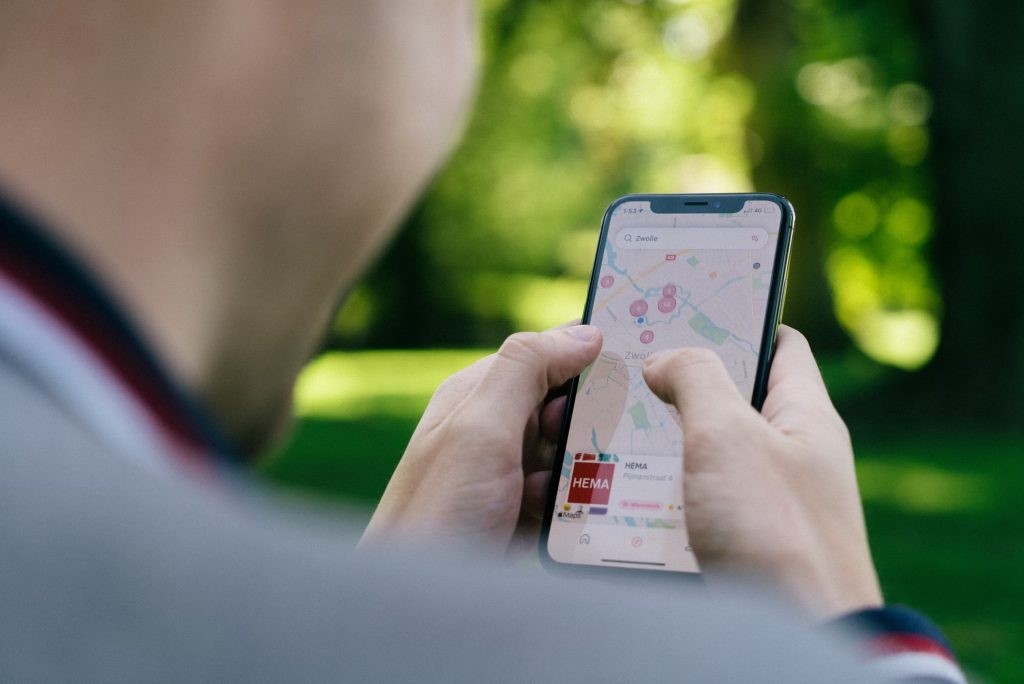 Woman using maps application on mobile device while on vacation
Woman using maps application on mobile device while on vacation
Woman using maps for directions. Source: Unsplash
1.2. Data Usage by App: A Detailed Breakdown
Different apps and services have varying data requirements. Here’s a detailed look at some common apps and their estimated data consumption:
| App Use | 1 Hour | 1 Week at 2 Hours Per Day |
|---|---|---|
| Google Maps | 5 MB to 10 MB | 70 MB to 140 MB |
| Spotify | 40 MB to 150 MB | 560 MB to 2 GB |
| Web Browsing | 10 MB to 25 MB | 140 MB to 350 MB |
| 100 MB to 200 MB | 1 GB to 3 GB | |
| WhatsApp Calls | 300 MB to 700 MB | 4 GB to 10 GB |
| YouTube | 300 MB to 2 GB | 4 GB to 35 GB |
| Google Meet | 1.5 GB | 16 GB to 21 GB |
Table: Estimated Data Usage for Common Apps
These figures are averages, and your actual data usage may vary based on your individual habits. Let’s take a closer look at each app to provide more detailed insights.
2. Analyzing Specific App Data Consumption
Understanding how different apps consume data is essential for planning your data needs while traveling. This section breaks down the data usage of popular apps like Google Meet, Instagram, YouTube, Spotify, and Google Maps.
2.1. Google Meet Data Usage
Google Meet’s data usage varies significantly depending on video quality and call duration. Consider these factors when estimating your data needs:
- Low-Quality Video (240p): Approximately 270 MB per hour.
- Standard-Definition Video (480p): Roughly 540 MB per hour.
- High-Definition Video (720p): Can exceed 1 GB per hour.
Hosting meetings in HD or sharing screens can consume even more data, potentially reaching 2.25 GB per hour for group calls. Using Google Meet on mobile devices may result in slightly lower data usage, averaging around 500 MB per hour, due to automatic optimizations.
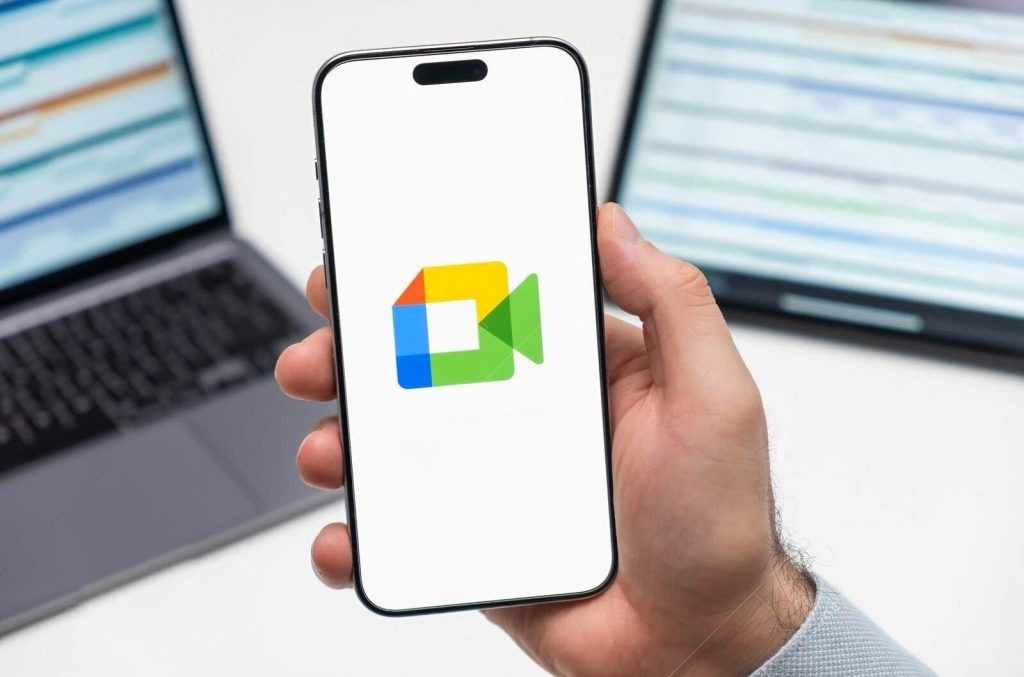 Google Meet logo on the screen of mobile phone in mans hand for travel planning
Google Meet logo on the screen of mobile phone in mans hand for travel planning
Google Meet loading on a mobile. Source: Freepik
2.2. Instagram Data Usage
Instagram’s data consumption depends on how actively you use the platform. Here’s a general breakdown:
- Normal Usage: 100 to 150 MB per hour for browsing feeds and viewing stories.
- Heavy Usage: Up to 1 GB per hour for watching reels, videos, or uploading high-resolution content.
If you frequently upload photos and videos or spend a lot of time watching reels, your Instagram data usage can quickly add up.
2.3. YouTube and Other Streaming Services
Streaming apps are data-intensive but perfect for entertainment during downtime. Here’s a look at YouTube’s data usage based on video quality:
- 144p: 30 to 90 MB per hour
- 480p: 480 to 660 MB per hour
- 1080p (HD): 2.5 to 4.1 GB per hour
- 4K (2160p): 5.5 to 23 GB per hour
- 8K (4320p): Up to 22.5 GB per hour
Netflix’s data usage is also significant:
- Standard Definition (SD): Up to 1 GB per hour
- High Definition (HD, 1080p): Up to 3 GB per hour
- Ultra High Definition (UHD, 4K): Up to 7 GB per hour
Here’s a comparison of data usage for other streaming services:
| Streaming Service | Standard Definition | High Definition | Ultra High Definition (4K) |
|---|---|---|---|
| Amazon Prime Video | 0.38 GB/hr | 1.4 GB/hr | 6.84 GB/hr |
| Disney+ | 0.7 GB/hr | 2.0 GB/hr | 7.7 GB/hr |
| Hulu | 0.65 GB/hr | 1.35 GB/hr | 7.2 GB/hr |
| Apple TV+ | 0.3 GB/hr | 0.7 GB/hr | 2.3 GB/hr |
| Max (HBO Max) | 0.3 GB/hr | 2.25 GB/hr | 7.7 GB/hr |
| Peacock | 0.3 GB/hr | 1.1 GB/hr | 7 GB/hr |
| ESPN+ | 0.3 GB/hr | 0.9 GB/hr | N/A |
| FuboTV | 1.2 GB/hr | 1.6 GB/hr | 7 GB/hr |
Table: Data Usage for Various Streaming Services
These estimates can vary based on content, device settings, and network conditions.
2.4. Spotify and Apple Music Data Usage
Music can enhance any journey, but streaming can consume a significant amount of data. Here’s a breakdown of Spotify’s data usage:
- Low Quality: 25 MB per hour
- Normal Quality: 40 MB per hour
- High Quality: 84 MB per hour
- Very High Quality: 150 MB per hour
For Apple Music users, here’s the data usage breakdown:
- High Efficiency: 30 MB per hour
- High Quality: 120 MB per hour
- Lossless: 720 MB per hour
- Hi-Res Lossless: 2.9 GB per hour
Downloading music in advance can significantly reduce your data consumption while traveling.
 Woman streaming music while traveling to Napa Valley
Woman streaming music while traveling to Napa Valley
Streaming music on mobile. Source: Unsplash
2.5. Google Maps Data Usage
Navigating efficiently with Google Maps is essential, but it’s important to understand the app’s data usage:
- Turn-by-Turn Navigation: Approximately 5 MB per hour, ideal for car or walking directions without frequent route changes.
- Active Use (Zooming and Searching): 15 MB per minute, especially when switching between routes or using satellite mode.
- Distance-Based Usage: Around 90 MB per mile for active navigation with continuous updates.
- Offline Map Downloads: 85 to 190 MB per city map, a great way to save data when you know your destination.
By downloading offline maps and minimizing active use, you can significantly reduce Google Maps’ data consumption.
3. Monitoring Your Data Usage
Staying on top of your data consumption is crucial to avoid unexpected charges. Here’s how to monitor your data usage and set alerts on your phone.
3.1. Checking Data Usage on Your Phone
Monitoring your data consumption on your phone is straightforward. Here’s how to do it on both Android and iPhone:
On Android:
- Go to Settings.
- Tap Connections.
- Select Data Usage.
- Choose Mobile Data Usage to view your data consumption for the current cycle.
- Scroll down to see individual app usage and identify the biggest data consumers.
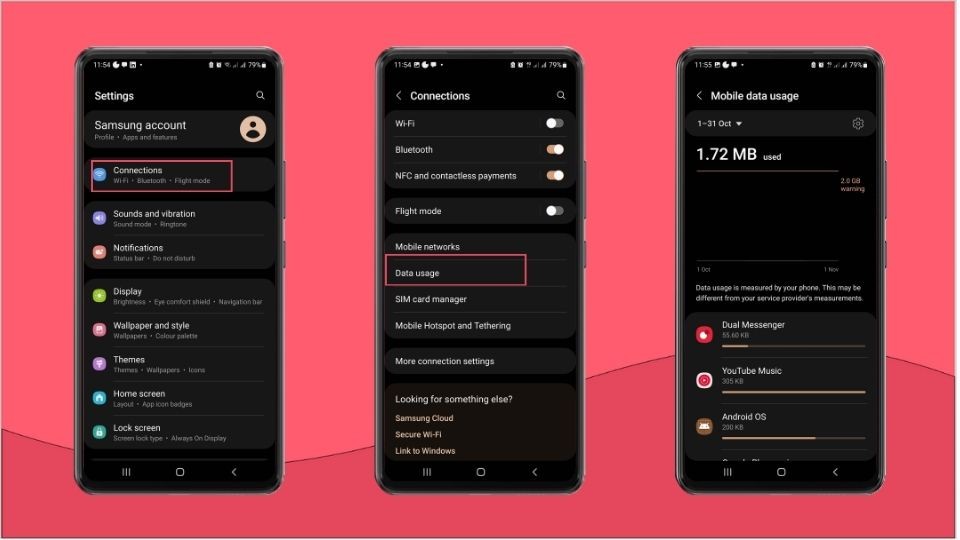 Screenshot of steps to check data usage in Android for travel
Screenshot of steps to check data usage in Android for travel
Easy steps to check data usage in Android
On iPhone:
- Open Settings.
- Tap Cellular or Mobile Service.
- View your total usage and app-specific data consumption.
- Manually reset Cellular Data Statistics at the start of each billing period to track usage.
By monitoring your data usage for one to three months, you can gain a clear understanding of your typical consumption patterns.
3.2. Setting Data Limits and Alerts
Setting data limits and alerts can help you avoid exceeding your data allowance. Here’s how to set them up on Android and iPhone:
On Android:
- Go to Settings.
- Tap Connections.
- Select Data Usage.
- Choose Billing Cycle and Data Warning.
- Set your billing cycle and enable Set Data Limit.
- Android will warn you as you approach your limit and can automatically stop data once you reach it.
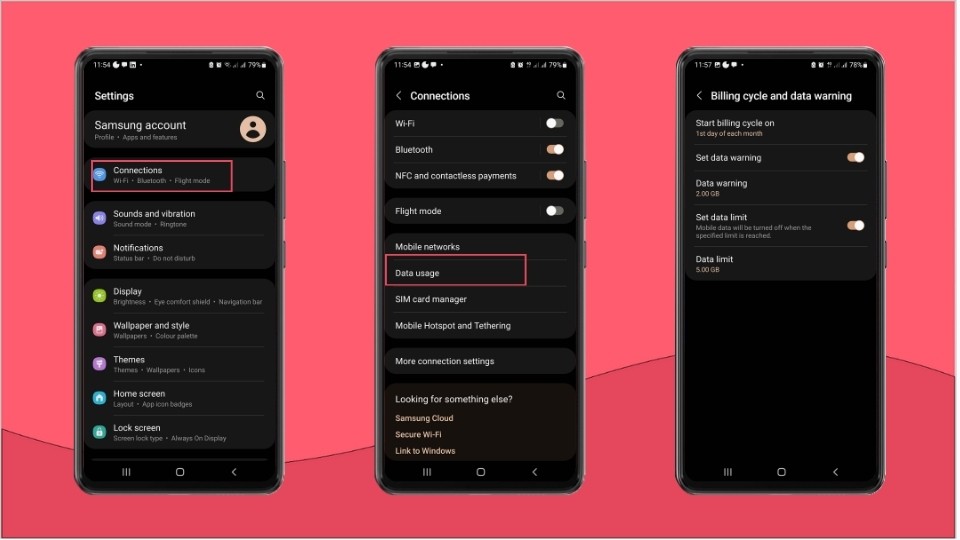 Screenshot of steps to check billing cycle in Android for travel
Screenshot of steps to check billing cycle in Android for travel
Easy steps to set billing cycle in Android
On iPhone:
- iPhones don’t have built-in data limit settings.
- Use Low Data Mode to reduce the amount of network data apps use.
- Go to Settings.
- Tap Cellular or Mobile Service.
- Select one of your numbers.
- Choose Data Mode.
- Turn on Low Data Mode.
By setting data limits and alerts, you can manage your data usage more effectively and avoid unexpected charges.
4. Practical Tips for Managing Data Usage While Traveling
Minimizing data consumption while traveling is essential for saving money and ensuring you stay connected when it matters most. Here are some practical tips to help you manage your data usage:
4.1. Implementing Data-Saving Techniques
Conserving data doesn’t have to mean sacrificing connectivity. Here are some strategies to help you use less data without missing out:
- Activate Data Saver Mode: Enable low data mode on your device to restrict background data, optimize app performance, and delay automatic synchronizations until you have WiFi.
- Deactivate Data Roaming When Not Needed: Disable data roaming in your settings during flights or when you don’t need data to prevent accidental charges.
- Download Maps for Offline Use: Download maps before your trip to navigate without using mobile data. This is especially helpful in areas with poor network coverage.
- Connect to Public WiFi: Use public WiFi for general browsing or messaging, but avoid accessing sensitive information on unsecured networks.
4.2. Exploring Connectivity Options
Staying connected without overspending requires exploring different connectivity options:
- International Data Plan: Check with your current mobile carrier about affordable international data plans or day passes.
- Local SIM Card: Purchase a local SIM card at the airport, convenience stores, or telecom shops. Make sure your phone is unlocked before swapping SIMs, and be aware of potential language barriers.
- eSIM (Embedded SIM): An eSIM is a virtual SIM card built into your phone, providing an efficient and cost-effective way to get international coverage.
4.3. Leveraging Travel Data Calculators
A travel data calculator can provide personalized estimates of your mobile data usage while abroad. By inputting information like your travel duration, activities, and app usage, you can get a clearer picture of your data needs and choose the right travel plan.
5. The Benefits of Unlimited Data with an eSIM
If you are planning a trip to Napa Valley, you want to stay connected to share every moment with your loved ones. Getting unlimited data with an eSIM is a great way to achieve this goal. An eSIM is a digital SIM card that you can install on your phone to access mobile data. This way, you can skip the physical SIM card and the associated hassle.
With an eSIM, you don’t have to worry about data roaming charges, which can be very expensive. An eSIM also allows you to switch between different carriers easily. The best part is that you can get unlimited data with an eSIM, so you don’t have to worry about running out of data while you are on your trip to Napa Valley.
Here are some benefits of getting unlimited data abroad with an eSIM:
- Cost-effective: eSIMs are typically more affordable than traditional SIM cards, especially if you need a lot of data.
- Convenient: You can purchase and activate an eSIM online, so you don’t have to go to a store.
- Flexible: You can choose an eSIM plan that meets your specific needs.
5.1. Holafly eSIM: Unlimited Data Across the Globe
For travelers seeking reliable, unlimited data without the stress of managing limits, a Holafly eSIM is an ideal choice. Holafly provides instant access to mobile networks in over 200 destinations, offering unlimited data plans for regions like Europe and Asia.
With Holafly, you can purchase an eSIM, scan the QR code, and set it up in just five minutes through the Holafly app, available for iOS and Android. This allows you to focus on your experiences rather than worry about data caps.
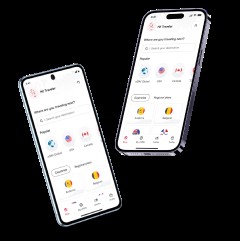 Traveler enjoying unlimited data with Holafly eSIM for travel planning
Traveler enjoying unlimited data with Holafly eSIM for travel planning
5.2. Advantages of Using Holafly eSIM
- Flexibility: Holafly offers plans ranging from 1 to 90 days, allowing you to choose the perfect duration for your trip.
- Seamless Connectivity: Enjoy uninterrupted data access, whether you’re on a weekend getaway or a month-long adventure.
- Number Retention: Keep your primary number active while traveling, making it easy to stay in touch with family and clients.
- 24/7 Customer Support: Holafly provides round-the-clock customer support, ensuring you’re never disconnected, no matter where your journey takes you.
Focus on moments, not data caps. Enhance your travel experience with seamless connectivity from TRAVELS.EDU.VN. Book your trip to Napa Valley with us and get a special offer on Holafly eSIM for worry-free data usage.
6. Frequently Asked Questions (FAQ)
Here are some frequently asked questions about data usage while traveling:
- How much data does Google Maps use per day for navigation?
- Google Maps typically uses about 5 MB per hour for turn-by-turn navigation. If you’re actively navigating for several hours a day, plan for around 50-100 MB.
- Can I use WhatsApp calls with minimal data?
- WhatsApp calls use approximately 300 MB to 700 MB per hour. To minimize data usage, use WhatsApp calls sparingly and prefer WiFi when available.
- Is it better to buy a local SIM card or use an eSIM for international travel?
- Both options have their advantages. Local SIM cards can be cheaper, but eSIMs offer convenience and the ability to switch plans easily.
- How can I prevent background data usage on my phone?
- You can restrict background data in your phone’s settings. On Android, go to Settings > Connections > Data Usage > Mobile Data Usage, and restrict background data for specific apps. On iPhone, use Low Data Mode.
- What is the best way to save data while streaming videos?
- Lower the video quality in your streaming app’s settings. Streaming in standard definition (SD) uses significantly less data than high definition (HD) or ultra-high definition (UHD).
- Are public WiFi networks safe to use for sensitive transactions?
- Public WiFi networks are often unsecured, so avoid accessing sensitive information like banking apps or personal accounts. Use a VPN for added security.
- How much data do social media apps like Facebook and Twitter use?
- Social media apps typically use 100 MB to 200 MB per hour, depending on how actively you use them. Watching videos and viewing images consume the most data.
- What is a travel data calculator, and how can it help me?
- A travel data calculator estimates your data usage based on your travel duration, activities, and app usage. This tool can help you choose the right travel plan for your needs.
- Can I use my regular phone number with an eSIM?
- Yes, Holafly and other eSIM providers allow you to keep your primary number active while traveling, making it easy to stay in touch with family and clients.
- What should I do if I run out of data while traveling?
- If you run out of data, consider purchasing a top-up plan from your eSIM provider or finding a local WiFi hotspot to stay connected.
7. Napa Valley Awaits: Enhance Your Trip with TRAVELS.EDU.VN
Planning a trip to Napa Valley? Let TRAVELS.EDU.VN take care of all your travel arrangements. From luxurious accommodations to exclusive wine tours, we offer tailor-made packages to suit your preferences. We understand the importance of staying connected. That’s why we partner with Holafly to provide our clients with seamless and affordable data solutions.
Napa Valley vineyards at sunset (Image from Tripadvisor)
7.1. Discover the Perks of Booking with TRAVELS.EDU.VN
- Personalized Napa Valley Itineraries: Let our travel experts curate your ideal itinerary, blending iconic wineries with hidden gems.
- Seamless Connectivity: With our Holafly eSIM partnership, enjoy worry-free data usage throughout your trip.
- Exclusive Access: Benefit from our connections to top-tier wineries and experiences.
- 24/7 Support: Our dedicated support team is available to assist you anytime, ensuring a smooth journey.
- Tailored Tour Packages: Choose from a variety of tour packages or create your own for a unique Napa Valley experience.
7.2. Contact Us Today
Ready to plan your dream Napa Valley getaway? Contact TRAVELS.EDU.VN today for expert advice and personalized service.
Address: 123 Main St, Napa, CA 94559, United States
WhatsApp: +1 (707) 257-5400
Website: TRAVELS.EDU.VN
Don’t wait, book your tour now and experience the best of Napa Valley with travels.edu.vn and stay connected with Holafly eSIM.
